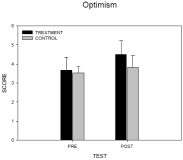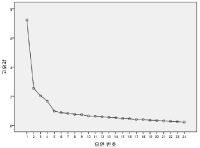PURPOSE This study aimed to identify movement pattern differences in the running of youth soccer players with and without lateral ankle sprain (LAS) histories. METHODS A total of 12 participants were recruited and assigned to the LAS group or the control group. All participants were assessed for anthropometric data, and they filled in the subjective ankle function questionnaires. Then, reflective markers were attached to their bodies, and they were instructed to run at the preferred speed on the 9-m runway thrice. 3D joint angles for ankle, knee, and hip joints were exported, and their mean values and 95% confidence intervals were calculated. Ensemble curve analysis was conducted to compare running kinematics between the groups. RESULTS The LAS group exhibited fewer dorsiflexion angles and more inversion angles compared to the control group. Excluding the dorsiflexion deficits and more inverted ankles, there were no significant differences between the groups. CONCLUSIONS Although the ankle kinematic patterns found in this paper are not considered LAS risk factors, it will be able to identify precise LAS risk factors with prospective design (e.g., lower extremity movement patterns) as well as intrinsic risk factors.
PURPOSE This study aimed to develop a team building program for a middle school soccer team in order to verify its effects. METHODS A total of 50 middle school soccer players participated in the needs analysis, and 10 middle school soccer players participated the preliminary program. In addition, a total of 37 ‘S’ middle school soccer players and 2 coaches participated the final team building program to identify its effects. The team building program was developed through the following sequence: program goal setting, organization of program activities, and the pretest. Three types of questionnaires and a self-report were utilized to verify the effects of the team building program. RESULTS The team building program was developed based on interpersonal relationships, goal setting, and communication. The level of team cohesion, team communication, and coach-athletes interaction significantly increased through this program. Furthermore, the effects of stress relief and self-improvement were revealed through the self-report. CONCLUSIONS The team building program was determined to be effective and has various benefits. It is expected to contribute to the growth of middle school soccer players if coaches actively participate in the program with their athletes.
This study aimed to explore elite taekwondo competitors’ imagery strategies . The study participants were 10 elite taekwondo athletes, who worked for S business team. Data were collected through open-ended questionnaires and in-depth interviews. The data were collected based on Gould et al. (1992)’s proposed qualitative research method. The inductive content analysis of the imagery was conducted following the imagery type of Paivio (1985) and Suinn (1996). The law data and case of imagery were separated by three specialists. The results were as follows. First, elite taekwondo competitors generally used the types of imagery proposed by Paivio (1985) and Suinn (1996). In particular, imagery of anxiety regulation appeared with the highest frequency among factors and ordered imagery of motivation, imagery of skills, imagery of mental skills, and imagery of competition. Second, elite taekwondo competitors mainly used imagery of skills before two weeks for competition. They mainly used imagery of anxiety regulation the day before a competition. They used imagery of anxiety regulation and imagery of motivation on the day of a competition. They used imagery of motivation after the competition. In sum, elite taekwondo competitors used individual strategies in terms of imagery in order to ensure effective training and peak performance in competition. The strategy of imagery was applied differently based on the juncture of the competition.
PURPOSE Taekwon gymnastics is expected to be a program that can overcome the management difficulties currently faced by Taekwondo gyms and contribute to the expansion of Taekwondo base. Therefore, this study aimed to examine the relationship among organizational identification, flow experience, intention to continue participation, and recommendation intention of Taekwon gymnastics participants. METHODS In this study, data was collected from 313 teenagers participating in Taekwon gymnastics at Taekwondo gyms in the metropolitan area from September 10 to 24, 2021. A total of 267 questionnaires were selected as the final sample, and data analysis was conducted using SPSS 23.0 and AMOS 23.0. RESULTS Organizational identification had a significant effect on flow experience, challenge only had a positive effect on intention to continue participation, flow experience did not significantly affect recommendation intention, and intention to continue participation had a significant effect on recommendation intention. CONCLUSIONS The results of this study confirmed that organizational identification can contribute to improving inner pleasure and self-esteem, and it is necessary to examine the role of factors that can mediate the relationship between flow experience and behavioral intention in the future. Furthermore, managers of Taekwondo gyms should hold various events that can inspire teenagers’ sense of challenge to encourage intention to continue participation.
PURPOSE This study aimed (1) to analyze the behavioral intention and use behavior among the consumers of online home training contents via YouTube by employing the unified theory of acceptance and use of technology (UTAUT); (2) to test the moderating effects of risk perception toward the coronavirus (COVID-19) infection, and 3) to test differential impacts of generational difference across millennial and baby boom generations. METHODS A total of 400 questionnaires were distributed, and 383 samples were used for the final analysis after excluding 17 incomplete responses. Data were analyzed using the SPSS 25.0 and AMOS 22.0. RESULTS It was found that (1) the performance expectancy, the effort expectancy, and the social influence had positive effects on behavioral intention; (2)the facilitating condition had negative effects on the use behavior; (3) the behavioral intention had positive impact on the use behavior. Moreover, the risk perception toward the COVID-19 infection did not have moderating impacts on the UTAUT model, whereas generational differences did. CONCLUSIONS Our results suggest that the marketing strategy that improves exercise performance, convenience, and social influencing factors may be key to home training customers' behavioral intention and use behavior. Furthermore, home training material makers should recognize that the features and infrastructure required for the two generations are distinct and develop a separate marketing strategy for each.
PURPOSE The purpose of this study was to understand the athletic identity of youth football players and to trace its changing trend. METHODS Participants of this study included 93 players in 2005 and 94 players in 2021, who were in middle and high schools. All participants answered open-ended questionnaires. After the results of the inductive content analysis, the changing trend of the results was assessed. RESULTS The athletic identity of youth football players were collected from 811 raw data samples collected in 2005 and 741 collected in 2021 and categorized into 19 sub-categories and 5 categories. The results show a tendency to be specific to football. The athletic identity of a football player itself is weakening, being replaced by the identity of being a student. The role of the camp is also weakening, while more privacy and autonomy are allowed to the players. As a result, efforts to secure the players’ right to study were accepted by the players, and expected to decrease as camp life with limited privacy is on the decline, and as senses toward one’s physical competence are changing. CONCLUSIONS Sociocultural contexts, including changes in the system and social modifications, are reflected in the football player's athletic identity and its changes. The athletic identity of youth football players has changed from its 2005 version of unacademic camp life with limited privacy to the 2021 version, where the player leaves camp to be provided with privacy and attend classes.
PURPOSE This study was conducted to investigate changes in stress before and after elite shooting athletes participate in a match, and to find out the effect on the match score. METHODS Thirty-wight elite shooting athletes were sampled, questionnaires were distributed to measure psychological stress before and after the match, and saliva was collected before and after the match to measure cortisol. In addition, psychological stress and changes in cortisol before and after the game were investigated, and how psychological stress before and after the game and cortisol affect the score of the game were investigated. Accordingly, a statistical analysis based on data analysis was conducted, and the following research results were obtained. RESULTS The pre-match analysis of psychological stress and cortisol revealed statistically significant changes; both post-match stress and cortisol decreased compared to before the match. Increased psychological stress and cortisol both before and after the match had a negative effect on the match score. CONCLUSIONS These findings confirmed that shooters experience very strong psycho-physiological stress before the match, and the stronger the psychological stress, the lower the game score.
PURPOSE This study was to examine safety awareness of sports among university students. METHODS Total 1950 university students of 9 regions responded to questionnaires on safety awareness of sports with using simple random sampling. The date were analyzed by frequency analysis and Two-way ANOVA. RESULTS The results of this study werew as follows: Fistly, male students were experienced safety awareness education more than female students. In addition, the education of safety awareness of sports took place in sports field, but most of students did not aware of safety personnel. Secondly, university students thought that sports was not safe because sports facilities and equipments were not managed and they were worn out. Thirdly, they perceived sports safety was managed generally normal. Furthermore, they perceived the aging of facilities and equipments at sports sites was major factor in the occurrence of safety accidents. In order to reduce sports safety accidents, it is necessary to facilitate safety education of sports at government. CONCLUSIONS The results of this study will be used as fundamental information to raise safety awareness in university students and to establish safe sports culture.

Purpose The goal of this study was to investigate the application effect of strength-based positive psychology intervention to elite archers. Methods Total of 20 elite archers participated in this study. Treatment group consisted of 10 elite archers participated in the strength-based positive psychology intervention for 8 weeks. Each individual responded the questionnaires in pre- and post-treatment sessions. Data were analyzed by repeated-measure ANOVA. Furthermore, archers participated in the program responded to in-depth interviews. Results According to the results, participants in strength-based positive psychology intervention showed that significantly increased strength knowledge, strength use, and optimism in the post–treatment compared to the pre-treatment session while control group did not show significant changes. In addition, archers perceived that there were positive effect on thinking ·coping and their self-confidence and self-esteem enhanced after participating the program. Conclusion The results of this study suggested that strength-based positive psychology intervention has positive impact on athlete’s wellbeing and perception of individuals strength and can be applicable to different sports field.



Purpose The purpose of this study was to develop the sport 5C scale of the Korean version. Methods The participants were 772 high school students from 17 to 19 who participated in sport regularly. The validation of Sport K-5C followed a three-step validation procedure through substantive stage, structural stage, and external stage. Results First, In the substantive stage, Sport K-5C consisted of 50 items with 5 factors. Second, in the structural stage, although Sport K-5C was explored as 24 items with 4 factors by EFA, but as a result of CFA, Sport K-5C was confirmed as 24 items with 5 factors. Third, the external stage provided additional validity through correlations of tests with other questionnaires which are similar concept and opposite concept, and group differentiation. Conclusions Sport K-5C is composed of 5 factors and 24 items. The factors are Caring, Character, Confidence, Competence, Connection. This scale can be used to provide an objective evaluation of positive development of youth in sport and physical education context.
